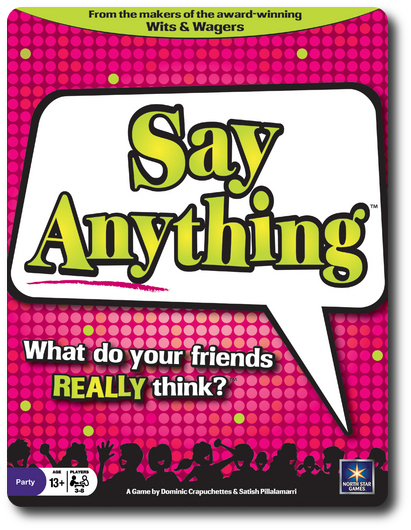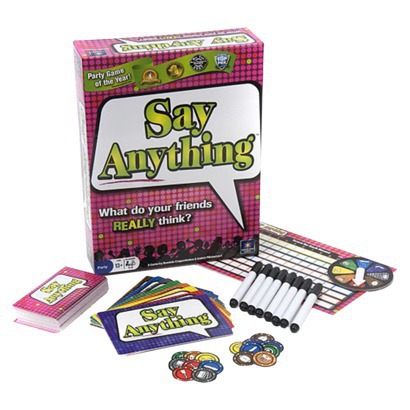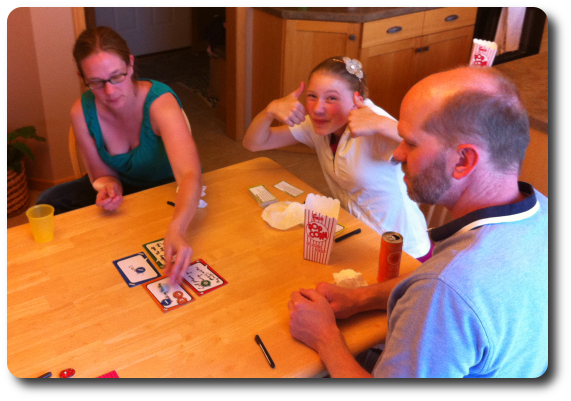
The Basics:
- For ages 7 and up (publisher suggests 13+)
- For 3 to 8 players
- Variable game length
Geek Skills:
- Active Listening & Communication
- Counting & Math
- Logical & Critical Decision Making
- Reading & Writing
- Pattern/Color Matching
- Imagination
- Betting
Learning Curve:
- Child – Easy
- Adult – Easy
Theme & Narrative:
- In this game, the only opinion that matters is yours, but only if everyone else agrees
Endorsements:
- Gamer Geek rejected!
- Parent Geek approved!
- Child Geek approved!
Overview
Everyone has an opinon. Heck, Father Geek wouldn’t exist if it weren’t for opinions (which, in our opinion, would be very sad). But if everyone has an opinion, is one better than another? Certainly an educated and thoughtful opinion would be of more value than a person’s opinion that is based purely on speculation and personal bias, right? Well, not always, and in this game, almost never. You still need to put thought into your opinion of what is the best answer to a random question (of which you might know nothing about), but the point is answering it in a way that others will agree to. Right or wrong, the answer that wins is the one that people enjoy the most.
Say Anything, by North Star Games, is comprised of 80 Question cards (5 questions per card for a total of 400 questions), 8 dry erase markers, 8 Answer boards, 1 SELECT-O-MATIC 5000 (a small disc that allows you to select an icon that matches the Answer boards), 16 Player tokens (2 per player), and 1 Score board. Not included in the game, but nice to have around, is a napkin or tissue that can be passed to the players after each round to help erase the Answer boards.

Example of all the bits in the game
Game Set Up
To set up the game, hand out to each player 1 dry erase marker, 1 Answer board, 2 Player tokens (that match the color and icon image on the Answer board), and a couple of napkins or tissues available to erase the Answer boards after each round of play. Inform the players that the tissues are not there if they start crying.
Select one player to be the Score Keeper. The Score Keeper is given the Score board and the very important job of recording each player’s score after each round. Give the SELECT-O-MATIC 500o to the first player.
That’s it! Get ready to say just about anything you like that might or might not be social appropriate or remotely accurate!
Asking & Answering Questions
The game is played in rounds. The number of rounds played is dependent on the number of players. For example, a 3 to 4 player game would require every player answer 3 questions for a total of 9 to 12 rounds of play, while a 7 to 8 player game would only require each player to answer 1 question for a total of 7 or 8 rounds of play.
When it is the player’s turn to ask the question, they are given the SELECT-O-MATIC 5000. This identifies them as the Question Giver for this round. The player then randomly selects 1 Question card and reads each of the questions on the card quietly to themselves. When they find a question they want to ask (and is appropriate for everyone at the gaming table), they read that question out-loud to all the other players.
All the players, except the Question Giver, now write down their answer on their own Answer board. It really doesn’t matter if the answer is technically correct and the players are encouraged to be as creative, if not accurate, as possible with their answers. Once the players are done writing their answer, their Answer boards are placed face-up on the table in front of the Question Giver in any order (as order simply does not matter). Players can continue to update their answer as long as they are not the last one with an Answer board. It should also be noted that a blank answer (nothing written on the Answer board) is perfectly fine, but will most likely not win any points.
The Question Giver now quietly reads each of the provided answers. Using the SELECT-O-MATIC 5000, the Question Giver aligns the arrow on the disc to match the color and icon of the Answer board that has the answer they most like. For example, if the Answer board with the icon of a football has the answer the Question Giver most enjoys, they would make sure the arrow on their SELECT-O-MATIC 5000 is pointing to the football icon. Players are welcome to argue the merits of their answers to the Question Giver if they think it will help and the Question Giver is welcome to ignore them.
The selection process using the SELECT-O-MATIC 5000 is done in secret and as much care as possible should be taken to ensure that none of the players see what the Question Giver selects. Once the Question Giver is done, they place their SELECT-O-MATIC 5000 in front of them, face-down, so that the selection cannot be seen by any of the other players.
All the other players (again, not the Question Giver) now take their Player tokens and place them on the Answer board they believe the Question Giver selected using the SELECT-O-MATIC 5000. Players can place both of their Player tokens on 1 Answer board or place 1 Player token on two different Answer boards for a total of 2 Answer boards selected. Players do not have to select their own Answer board, but are welcome to if they think it will help.
The SELECT-O-MATIC 5000 is now flipped over showing which Answer board was selected by the Question Giver. At this time, all the players should demand the Question Giver explain their selection and tell them how wrong or right they were. The Score Keeper now records points for each player for the round on the Score board. The number of points awarded are as follows:
- The Question Giver is awarded 1 point for every Player token placed on the Answer board that matches their selection with the SELECT-O-MATIC 5000
- Each player is awarded 1 point for every Player token they placed on the Answer board the Question Giver selected
- The player who owns the Answer board that was selected by the Question Giver is awarded 1 point
Everyone else gets diddly and should be very vocal about it.
The maximum number of points a player can ever receive in a single round of scoring is 3 points, regardless of where points come from. To ensure that proper scoring is completed, the Score Keeper should be the only player who says when retrieving the Player tokens and Answer boards is appropriate. Slapping of hands who wander too close to the Player tokens is not directly stated in the rules, but implied (by me).
This ends the round. If the endgame condition has been met, the game now ends, otherwise, the SELECT-O-MATIC 5000 is passed to the next player going clock-wise. The new player is now the Question Giver who selects a Question card. The rounds continue as described above until the endgame condition is met.
Endgame and Final Scoring
The game ends when all the players have completed their last turn. The number of turns is dependent on the number of players.
The Score Keeper now determines each player’s total points using the Score board. The player with the most points wins the game and is most likely going to be treated by his friends and family with a little bit of disdain. This is perfectly natural and encouraged.
To learn more about Say Anything, see the game’s official web page.
Prediction
There isnt’ much to this game, but it’s a hard one to predict. What will determine if this is a successful game or not are the player’s attitudes towards the game and to each other. To be fair, a groups perception of any game and their attitude at the gaming table has always influenced their final level of endorsement, but none more so than a party game. Especially if that party game is heavily dependent on the players to make the game fun.
Which Say Anything is.
The publishers suggest that it should take about 2 minutes to teach the game. I think not. The game can be summarized in less than 30 seconds, but the focus of that summary should not be on the game’s play or mechanisms, but on the intent of the game. This is, after all, a party game and all party games just want to have fun (extra points for me for getting in a Cyndi Lauper reference in this review). Making certain the players understand that intent should help get this game off the ground. Here is how I taught the game to all our groups.
“You’ll be asked a question and you should answer it in a way that everyone at the table will enjoy. After everyone writes down their answer, one player will select which answer they think is the best and all the other players guess which answer that is. You’ll get points when people like your answer, and at the end of the game, the player with the most points wins.”
That’s all the players needed, regardless of their age or experience level, to understand and play the game. I purposely kept it simple and emphasised the intent was to amuse and interact with the other players. This is not a game that is played so much in the player’s mind but at the table. Conversation is a must and laughter is essential. While points are collected, everyone wins if the game amuses the group.
And so, after explaining the game to family and friends, I asked my little geek his thoughts on the game so far.
“If I heard you right, all I have to do is be funny, have fun, and I’ll win the game no matter how many points I have.” ~ Liam (age 7)
I could not have said it any better myself. Let’s see if Say Anything is a hit with our groups or, in the end, there really isn’t much to say about it.
Final Word
My little geek rather enjoyed the game and spent most of the time laughing. He was noticeably upset at first when his answers were not selected, but he gradually got over it. He started to focus more and more on trying to read the table and select what he thought was the most amusing answers. Luckily, that is exactly what the other players were doing, making it an easy task. Since all the players were purposely trying to amuse each other, the answers provided were hilarious.
Parent Geeks and non-gamers agreed Say Anything was a light and amusing party game. One Parent Geek remarked that the game’s real charm was in learning more about the people at the table. A non-gamer liked the fact they could play the game competitively without feeling competitive. A Parent Geek looked at me during the game and asked, “so, this is the game?” When I said it was, she smiled and said, “Not much of a game, but I’m really liking it.” That statement pretty much sums up the Parent Geeks and non-gamers thoughts on their overall game experience.
Gamer Geeks enjoyed the people they played the game with, but didn’t think the game was all that great. This is an important point to emphasis as Gamer Geeks focus a great deal on the game itself, the strategy needed to beat it and their opponents. While I am certain you could argue Say Anything has some level of strategy and tactics to it, most Gamer Geeks will roll their eyes at you if you suggest it. This is, in their mind, a party game that is meant to create laughter at the table. They enjoyed themselves while playing it, which resulted in giving the experience, not the game, a thumbs up.

A little geek gives the game her approval while the Gamer and Parent Geek think it over
Gamer Geeks, this is a party game that requires the players to bring both the party and the game. Say Anything is light even for party games and should not be looked at as a game so much as provider for conversational context. The points collected can be influenced by purposely tailoring your answers to please the table, which sounds like cheating, but is the game’s main intent. If you aren’t having fun playing the game, you are doing it wrong, but don’t think for a moment this is a gamer’s game. It’s a party game that won’t take you seriously, so you should return the favor and not take it seriously, either.
Parent Geeks, this is a fun way to get to know the people around the gaming table a bit better and have a laugh while doing so. Some of the questions are highly subjective and don’t lend themselves to hilarity. For example, how does one answer a question about the best pizza topping with a dry wit? Other questions, such as the one that asks you what would be the most fun thing to throw off a tall building will make you pause, as I’m sure that there are many things you’d like to throw, but probably shouldn’t. In the end, the game is not about being honest with yourself, but not taking yourself seriously. When you let go and answer the questions with the first thing that comes to mind, you’ll find that your answer is surprisingly good. Where you will find the most fun is arguing for or against an answer. The creative and sarcastic banter that will be flying about the table is what will make this game the life of your party.
Child Geeks, some of the questions you are going to be asked won’t make any sense to you. For example, I cannot believe there are many little geeks walking about town pondering which famous person would be the most comical in a musical. But that really doesn’t matter. Don’t look at trying to answer the questions as an adult would. Adults are boring. If you have an opinion, you’re set. For example, do you know who would be really good in a comical musical? Phineas and Ferb, that’s who.
A quick word on the questions in the game. Some questions are not what I would consider little geek appropriate. For example, I wouldn’t feel comfortable asking a little geek to write down their answer to what is the sexiest trait found in a man. However, questions that shouldn’t be asked in front of or to a little geek are exceedingly limited. There are 400 questions in the game, after all, and each Question card will give 5 questions. The odds are exceedingly good that 2 or more questions will be just fine. If, however, you don’t want to deal with the headache of having to very briefly review the questions on every card, there is a family version of the game available.
Say Anything is a wonderful party game that will generate much laughter, and most certainly, arguments. It is also a game that his heavily dependent on players sharing a common mindset as well as humor. Depending on the group the game is played with, it will be an incredible success or a dismal failure. This is a game that requires the players to do all the work and make their own fun. If the players are up for it, they should expect to have a blast.
If you are looking for a party game that asks the players to say the first thing that comes to mind with the intent of amusing themselves and the others at the table, then look no further than Say Anything. It is sure to be a game that will bring laughter, debates, and interesting insight about your family, your friends, and yourself….in our opinion.
This game was given to Father Geek as a review copy. Father Geek was not paid, bribed, wined, dined, or threatened in vain hopes of influencing this review. Such is the statuesque and legendary integrity of Father Geek.




Sounds like a fun game! Relaxed, funny games are a big hit in my house.
Oh, very relaxed…at first. As the game progresses, the player energy level rises and the wildly inaccurate accusations of favoritism, blatant pandering to the table, and subtle suggestions of bribes to the Question Giver increase exponentially in number.
A good time for the entire family!
And if you want to see the game played, it’s featured this week on Tabletop
The link didn’t show up. Here it is in text http://youtu.be/_7BsVb-5wDs
Yep, embedding videos in the comments is a no-no. Links are super duper OK, Daddy-Oh.
Pingback: Say Anything Family Edition Game Review » Father Geek